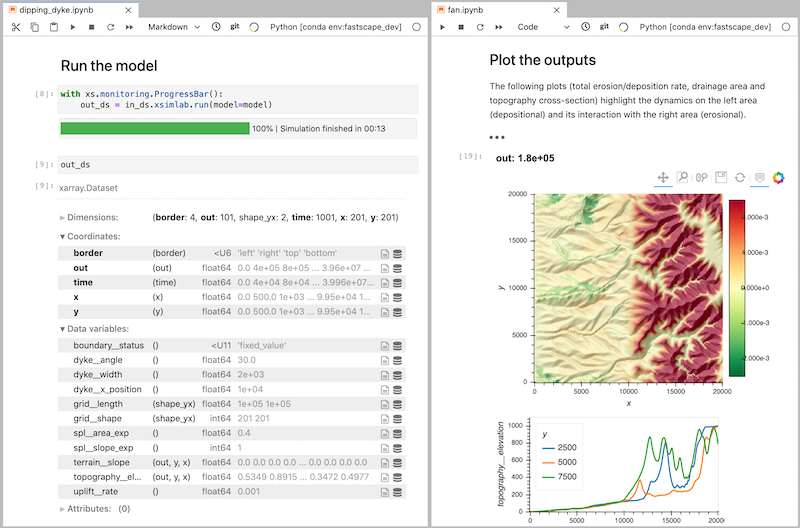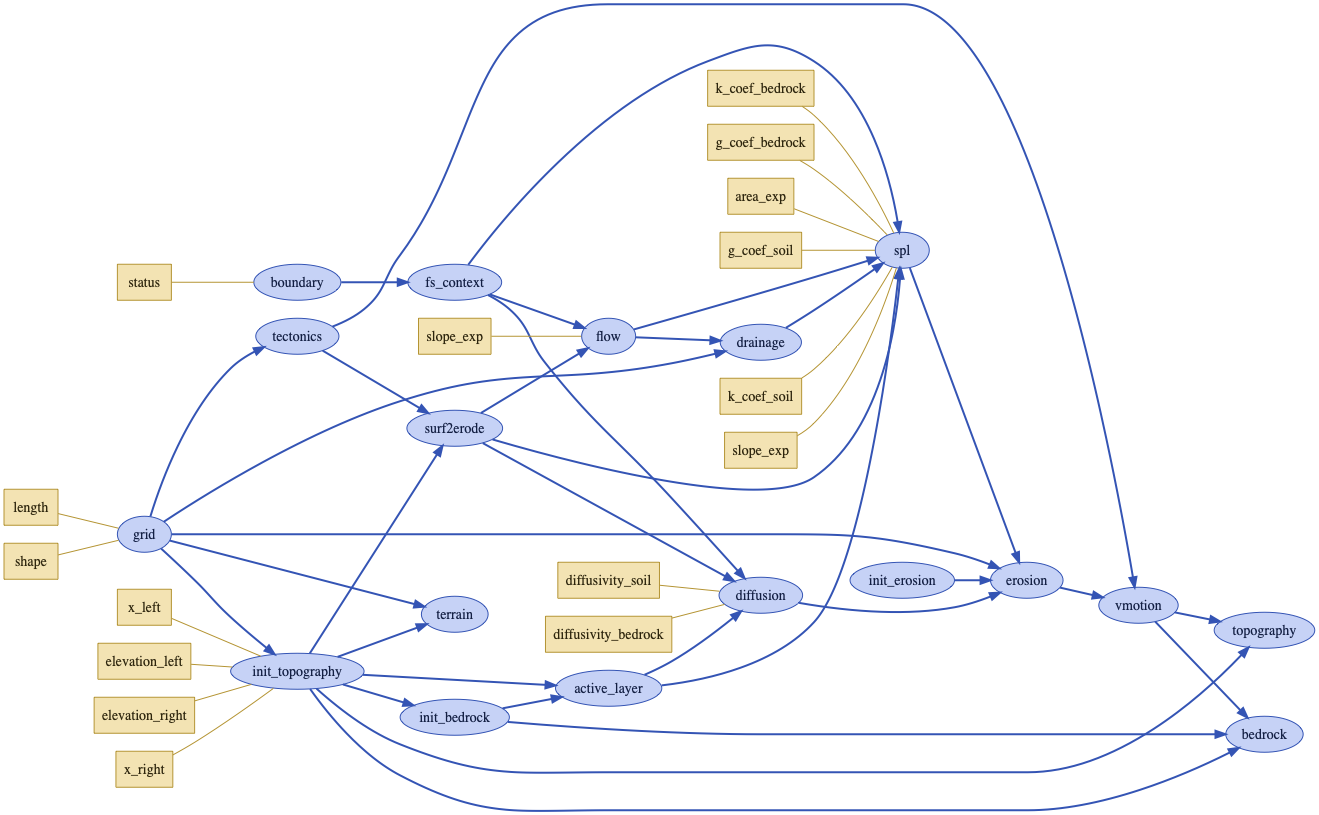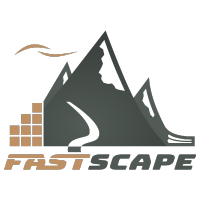Fastscape Toolbox
Fastscape is a set of open-source software components aimed at making landscape evolution models and topographic analysis algorithms readily accessible to a wide range of users.
Cite this software
Description
Fastscape is a set of open-source software components aimed at making landscape evolution models and topographic analysis algorithms readily accessible to a wide range of users, from experts in landscape evolution modelling to scientists, researchers and teachers in the broader Earth science community.
Please note: the whole Fastscape ecosystem consists of multiple code repositories. Most of them are hosted under the following GitHub organization: https://github.com/fastscape-lem. The DOI above is only for the top-level "fastscape" code repository. DOIs are also available for the other components.
Fastscape
Fastscape is a flexible and modular landscape evolution model that is highly connected to the Python scientific ecosystem, thanks to the Xarray-simlab modeling framework (see below). It provides +30 components that can be combined together in order to create custom models. Users can also plug in their own components. Its high-level, user-friendly interface enables interactive landscape evolution modeling, e.g., within Jupyter notebooks.
- Code repository: https://github.com/fastscape-lem/fastscape
- Documentation: https://fastscape.readthedocs.io

Fastscapelib (Fortran)
Fastscapelib-Fortran implements efficient algorithms for landscape evolution modeling. It provides a basic Fortran interface with model setup, runtime and I/O routines that can be used in standalone programs or for coupling landscape evolution models with other Fortran codes (e.g., tectonic or climate models).
- Code repository: https://github.com/fastscape-lem/fastscapelib-fortran
- Documentation: https://fastscape.org/fastscapelib-fortran/

Fastscapelib (C++)
Fastscapelib (C++) is the successor of Fastscapelib-Fortran. It provides a very flexible, yet optimized system for implementing various core algorithms (e.g., flow routing and enforcement, solvers for erosion processes) on multiple grids. It exposes a C++ API that is compatible with the Xtensor library (i.e., a multi-dimensional array library heavily inspired by NumPy). It also exposes a Python/NumPy API and may have language bindings for R and Julia.
- Code repository: https://github.com/fastscape-lem/fastscapelib
- Documentation: https://fastscapelib.readthedocs.io
Xarray-simlab
Xarray-simlab is a modeling framework used by "Fastscape" to build, setup and run custom models. It is very well integrated with tools of the Python Scientific / PyData / Pangeo ecosystems such as Xarray, Dask, Zarr and the Holoviz projects. It is a generic framework that can be used to build models in a wide range of domains.
- Code repository: https://github.com/xarray-contrib/xarray-simlab
- Documentation: https://xarray-simlab.readthedocs.io

Extensions and Tools
- Ipyfastscape: interactive widgets for topographic data analysis and modelling in Jupyter notebooks.
- AdaScape: adaptive speciation and landscape evolution model
- VariableSPIM: variable discharge stream power incision model
- Orographic Precipitation: linear theory of orographic precipitation
- Fastscape-Litho: feeding Fastscape with a 3D bloc of lithology with differential erodibility, diffusion and other
- Gilbert Board: a variant of the Galton Board built with Fastscape and Jupyter widgets
- Landscape Booth: a live photo booth with a fancy "landscape evolution" filter (outreach LNDW 2023)

- BSD-3-Clause
- GPL-3.0-only
Participating organisations
Mentions
- 1.Author(s): Benjamin Gérard, Delphine Rouby, Ritske S. Huismans, Cécile Robin, Charlotte Fillon, Jean BraunPublished in Journal of Geophysical Research: Solid Earth by American Geophysical Union (AGU) in 202310.1029/2022jb024967
- 2.Author(s): X.P. Yuan, R. Jiao, J. Liu-Zeng, G. Dupont-Nivet, S.G. Wolf, X. ShenPublished in Earth and Planetary Science Letters by Elsevier BV in 2023, page: 11801710.1016/j.epsl.2023.118017
- 3.Author(s): Pilar Ávila, Milagros Ávila, Federico M. Dávila, Miguel Ezpeleta, Nesvit E. CastellanoPublished in Tectonophysics by Elsevier BV in 2023, page: 22997110.1016/j.tecto.2023.229971
- 4.Author(s): Ruohong Jiao, Jean Braun, Antoine Delaunay, Cécile Robin, François GuillocheauPublished in Earth Surface Processes and Landforms by Wiley in 2022, page: 215-22910.1002/esp.5482
- 5.Author(s): X. P. Yuan, R. Jiao, G. Dupont‐Nivet, X. ShenPublished in Geophysical Research Letters by American Geophysical Union (AGU) in 202210.1029/2021gl097623
- 6.Author(s): Derek Neuharth, Sascha Brune, Thilo Wrona, Anne Glerum, Jean Braun, Xiaoping YuanPublished in Tectonics by American Geophysical Union (AGU) in 202210.1029/2021tc007166
- 7.Author(s): Alexander Koptev, Matthias Nettesheim, Sarah Falkowski, Todd A. EhlersPublished in Scientific Reports by Springer Science and Business Media LLC in 202210.1038/s41598-022-17644-8
- 8.Author(s): Brendan Simon, Cécile Robin, Delphine Rouby, Jean Braun, François GuillocheauPublished in Basin Research by Wiley in 2022, page: 2064-208410.1111/bre.12696
- 9.Author(s): Lorenz Wolf, Ritske S. Huismans, Delphine Rouby, Robert L. Gawthorpe, Sebastian G. WolfPublished in Journal of Geophysical Research: Solid Earth by American Geophysical Union (AGU) in 202210.1029/2021jb023490
- 10.Author(s): Lorenz Wolf, Ritske S. Huismans, Sebastian G. Wolf, Delphine Rouby, Dave A. MayPublished in Journal of Geophysical Research: Solid Earth by American Geophysical Union (AGU) in 202210.1029/2022jb024687
- 11.Author(s): X. P. Yuan, L. Guerit, J. Braun, D. Rouby, C. M. ShobePublished in Journal of Geophysical Research: Solid Earth by American Geophysical Union (AGU) in 202210.1029/2021jb023510
- 12.Author(s): Sebastian G. Wolf, Ritske S. Huismans, Jean Braun, Xiaoping YuanPublished in Nature by Springer Science and Business Media LLC in 2022, page: 516-52110.1038/s41586-022-04700-6
- 13.Author(s): Shaidu Shaban, Christopher A. Scholz, Liang XuePublished in SSRN Electronic Journal by Elsevier BV in 202210.2139/ssrn.4309759
- 14.Author(s): Jean BraunPublished in Earth Surface Dynamics by Copernicus GmbH in 2022, page: 301-32710.5194/esurf-10-301-2022
- 15.Author(s): Alexander Koptev, Matthias Nettesheim, Todd A. EhlersPublished in Terra Nova by Wiley in 2022, page: 210-22310.1111/ter.12581
- 16.Author(s): Thomas Bernard, Hugh D. SinclairPublished in Basin Research by Wiley in 2022, page: 642-66110.1111/bre.12727
- 17.Author(s): X.P. Yuan, K.L. Huppert, J. Braun, X. Shen, J. Liu-Zeng, L. Guerit, S.G. Wolf, J.F. Zhang, M. JolivetPublished in Geology by Geological Society of America in 2021, page: 60-6510.1130/g49022.1
- 18.Author(s): Jessica R. Stanley, Jean Braun, Guillaume Baby, François Guillocheau, Cécile Robin, Rebecca M. Flowers, Roderick Brown, Mark Wildman, Romain BeucherPublished in Journal of Geophysical Research: Solid Earth by American Geophysical Union (AGU) in 202110.1029/2020jb021243
- 19.Author(s): Derek Neuharth, Sascha Brune, Anne Glerum, Chris K. Morley, Xiaoping Yuan, Jean BraunPublished in Geology by Geological Society of America in 2021, page: 361-36510.1130/g49351.1
- 20.Author(s): Thomas Bernard, Hugh D. Sinclair, Boris Gailleton, Matthew FoxPublished in Geophysical Research Letters by American Geophysical Union (AGU) in 202110.1029/2020gl092210
- 21.Author(s): Sebastian G. Wolf, Ritske S. Huismans, Josep‐Anton Muñoz, Magdalena Ellis Curry, Peter van der BeekPublished in Journal of Geophysical Research: Solid Earth by American Geophysical Union (AGU) in 202110.1029/2020jb021168
- 22.Author(s): Federico M. Dávila, Federico Martina, Mauricio Parra, Pilar ÁvilaPublished in Tectonics by American Geophysical Union (AGU) in 202110.1029/2021tc006855
- 23.Author(s): Andrew Darling, Kelin Whipple, Paul Bierman, Brian Clarke, Arjun HeimsathPublished in Earth Surface Processes and Landforms by Wiley in 2020, page: 312-33010.1002/esp.4730
- 24.Author(s): Ruohong Jiao, Jean Braun, Katherine KravitzPublished in Geophysical Research Letters by American Geophysical Union (AGU) in 202010.1029/2020gl089627
- 25.Author(s): R. Beucher, R. S. HuismansPublished in Geochemistry, Geophysics, Geosystems by American Geophysical Union (AGU) in 202010.1029/2019gc008884
- 26.Author(s): X. P. Yuan, J. Braun, L. Guerit, D. Rouby, G. CordonnierPublished in Journal of Geophysical Research: Earth Surface by American Geophysical Union (AGU) in 2019, page: 1346-136510.1029/2018jf004867
- 27.Author(s): Vivi Kathrine Pedersen, Jean Braun, Ritske S. HuismansPublished in Geomorphology by Elsevier BV in 2019, page: 225-23010.1016/j.geomorph.2018.12.015
- 28.Author(s): X.P. Yuan, J. Braun, L. Guerit, B. Simon, B. Bovy, D. Rouby, C. Robin, R. JiaoPublished in Earth and Planetary Science Letters by Elsevier BV in 2019, page: 11572810.1016/j.epsl.2019.115728
- 29.Author(s): Jean BraunPublished in Gondwana Research by Elsevier BV in 2019, page: 174-17610.1016/j.gr.2018.10.003
- 30.Author(s): Gregory Ruetenik, Robert Moucha, Bas de BoerPublished in Earth and Planetary Science Letters by Elsevier BV in 2019, page: 11575910.1016/j.epsl.2019.115759
- 31.Author(s): Guillaume Cordonnier, Benoît Bovy, Jean BraunPublished in Earth Surface Dynamics by Copernicus GmbH in 2019, page: 549-56210.5194/esurf-7-549-2019
- 32.Author(s): Audrey Margirier, Jean Braun, Xavier Robert, Laurence AudinPublished in Tectonophysics by Elsevier BV in 2018, page: 119-12910.1016/j.tecto.2018.02.009
- 33.Author(s): Vivi K. Pedersen, Jean Braun, Ritske S. HuismansPublished in Geomorphology by Elsevier BV in 2018, page: 467-48510.1016/j.geomorph.2017.11.025
- 34.Author(s): Jean BraunPublished in Gondwana Research by Elsevier BV in 2018, page: 209-22410.1016/j.gr.2017.04.012
- 35.Author(s): Jean Braun, Sean D. WillettPublished in Geomorphology by Elsevier BV in 2013, page: 170-17910.1016/j.geomorph.2012.10.008
- 1.Author(s): Hannah Sophia Davies, Sylvain Bouley, David Baratoux, Jean BraunPublished by Copernicus GmbH in 202310.5194/egusphere-egu23-8505
- 2.Author(s): Xiaodan Ma, Jianping Huang, Michael Sprenger, Michaela Imelda Hegglin, Patrick Jöckel, Tianliang ZhaoPublished by Copernicus GmbH in 202310.5194/egusphere-egu23-1594
- 3.Author(s): Ameha Muluneh, Sascha Brune, Giacomo Corti, Derek KeirPublished by Copernicus GmbH in 202310.5194/egusphere-egu23-11421
- 4.Author(s): Amanda Wild, Jean Braun, Alex Whittaker, Sébastien Castelltort, Charlotte FillonPublished by Copernicus GmbH in 202310.5194/egusphere-egu23-14437
- 5.Author(s): Marina Ruiz Sánchez-Oro, Simon M Mudd, Boris GailletonPublished by Copernicus GmbH in 202310.5194/egusphere-egu23-6003
- 6.Author(s): Esteban Acevedo-Trejos, Jean Braun, Katherine Kravitz, N. Alexia Raharinirina, Benoît BovyPublished by Copernicus GmbH in 202310.5194/gmd-2023-72
- 7.Author(s): Caroline Fenske, Jean Braun, François Guillocheau, Cécile RobinPublished by Copernicus GmbH in 202310.5194/egusphere-egu23-6886
- 8.Author(s): Frank Zwaan, Sascha Brune, Anne Glerum, John Naliboff, Dylan VaseyPublished by Copernicus GmbH in 202310.5194/egusphere-egu23-2573
- 9.Author(s): Kai Li, Sascha Brune, Derek Neuharth, Geoffroy Mohn, Anne Glerum, Zoltan ErdösPublished by Copernicus GmbH in 202310.5194/egusphere-egu23-7518
- 10.Author(s): Esther Heckenbach, Sascha Brune, Anne Glerum, Derek NeuharthPublished by Copernicus GmbH in 202210.5194/egusphere-egu22-5427
- 11.Author(s): Amanda Wild, Jean Braun, Alex Whittaker, Charlotte Fillon, Sébastien CastelltortPublished by Copernicus GmbH in 202210.5194/egusphere-egu22-5582
- 12.Author(s): Anne Voigtländer, Jens M Turowski, Boris GailletonPublished by Copernicus GmbH in 202210.5194/egusphere-egu22-1724
- 13.Author(s): Sebastian G. Wolf, Ritske S. Huismans, Jean Braun, Xiaoping YuanPublished by Copernicus GmbH in 202210.5194/egusphere-egu22-8815
- 14.Author(s): Michaël Pons, Stephan V. Sobolev, Sibiao Liu, Derek NeuharthPublished by California Digital Library (CDL) in 202210.31223/x5z34n
- 15.Author(s): Satarupa Mitra, Shailendra Pundir, Rahul Devrani, Aman Arora, Manish Pandey, Romulus Costache and, Saeid JanizadehPublished in Advances in Remote Sensing Technology and the Three Poles by Wiley in 2022, page: 49-5710.1002/9781119787754.ch4
- 16.Author(s): Benjamin Gérard, Delphine Rouby, Ritske S. Huismans, Cécile Robin, Charlotte Fillon, Jean BraunPublished by Wiley in 202210.1002/essoar.10511622.1
- 17.Author(s): Benjamin Gérard, Delphine Rouby, Ritske Huismans, Cécile RobinPublished by Copernicus GmbH in 202210.5194/egusphere-egu22-2781
- 18.Author(s): Caroline Fenske, Jean Braun, François Guillocheau, Cécile RobinPublished by Copernicus GmbH in 202210.5194/egusphere-egu22-4412
- 19.Author(s): David Whipp, Lars KaislaniemiPublished by Copernicus GmbH in 202010.5194/egusphere-egu2020-20549
- 20.Author(s): Benoit Bovy, Jean Braun, Guillaume Cordonnier, Raphael Lange, Xiaoping YuanPublished by Copernicus GmbH in 202010.5194/egusphere-egu2020-9474
- 21.Author(s): Sebastian G. Wolf, Ritske S. Huismans, Jean Braun, Xiaoping YuanPublished by Copernicus GmbH in 202010.5194/egusphere-egu2020-4317
- 22.Author(s): Lorenz Michel, Ritske S. Huismans, Sebastian G. WolfPublished by Copernicus GmbH in 202010.5194/egusphere-egu2020-9056